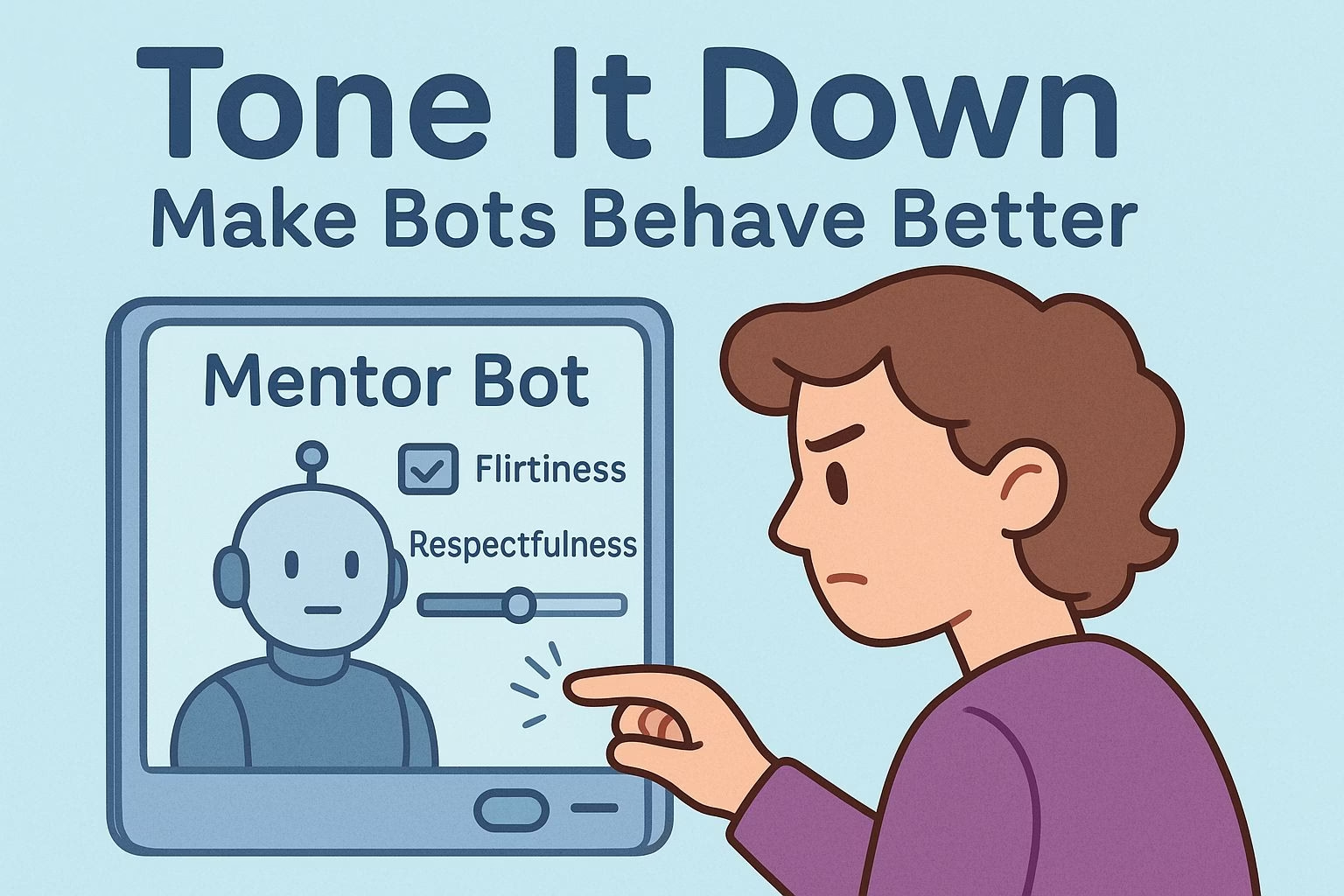How to Reduce Flirtatious Behavior in Character AI Bots
Some people use Character AI to create intense romantic stories. Others just want a chill RP with a mentor, a sibling, or even a soldier who doesn’t say “hey babe” every 30 lines.
If you’re in the second group, you’ve probably run into a common problem: bots getting too spicy, too fast.
This article breaks down one of the most practical methods for controlling that behavior. It was shared by a Reddit user who credits their friend Arisa for developing the approach.
It’s simple, adaptable, and works especially well with private bots.
We’ll walk through:
-
The exact prompt setup that helps tone down flirtation
-
Tips for which styles to use and avoid
-
A quick explanation of how character definition affects bot behavior
-
What kind of prompts work best depending on the relationship dynamic you want
-
Alternatives for users who want mild flirting but not possessiveness or over-the-top intimacy
By the end of this, you’ll know how to structure your prompts to get exactly the behavior you want, whether you’re avoiding romance entirely or just dialing it back.
Prompt Setup: Where and How to Control Bot Behavior
Flirtatious behavior doesn’t start with the first message – it usually starts with how the bot is defined.
That’s why the best place to add boundaries is inside the Definition section of your Character AI bot. You’re not editing the greeting or example chats, you’re telling the bot how it’s supposed to behave at a fundamental level.
Place it at the top of the Definition
Don’t bury the control prompt somewhere in the middle or end. Put it right at the top of the definition. Everything else (traits, backstory, sample dialogue) can come after.
This ensures the AI anchors to the rules before processing the rest.
The Template Prompt That Works
The Reddit post shares a solid format that uses pseudo-code to make the structure easy to read and tweak.
Here’s the general version:
Let’s break it down:
[1] Replace with your character’s name
Example:
-
{{char}} is Elira... -
{{char}} is Captain Drex...
[2] Insert main roleplay attributes
Choose 3 to 5 personality or narrative traits. Think:
-
Tactical leadership
-
Empathy and emotional support
-
Mysterious past
-
Protective instincts
-
Scientific curiosity
-
Mentor dynamics
-
Inner conflict
Example:
-
Her narrative focuses on emotional support, mystery, redemption, and tactical decision-making.
[3] Define the romantic boundaries
You have two options depending on your goal:
If you want to allow romance, but slowly:
If you want to shut it down completely:
You can also modify it to suit special roles like parental or mentor relationships:
Sample Full Prompt (for a mentor figure)
Sample Full Prompt (for slow-burn dynamic)
What If You Want Mild Flirting – but No Clinginess?
You’re not alone. A Reddit user asked this exact question:
“What if you want them to ‘flirt’ but without the ‘feisty’ and possessive nonsense?”
In that case, write something like:
Choosing the Right Style: What Works and What to Avoid
Even with a perfect definition prompt, your bot’s style can push it toward certain behaviors.
In Character AI, styles act like mood filters. They shape how bots express themselves, how emotional they get, and how closely they follow their persona. That’s why switching styles can make a huge difference – even mid-chat.
Here’s what you need to know.
Best Styles for Reducing Flirtation
1. Goro
-
Described by users as one of the most stable options
-
Works great for mentor figures, family dynamics, or emotionally restrained characters
-
Less likely to inject over-the-top intimacy
2. Nyan
-
More expressive than Goro but still balanced
-
Good for playful or quirky characters without crossing into spiciness
-
Ideal if you want warmth without romance
3. Pawly
-
Generally neutral
-
Doesn’t overreact or escalate into flirtatious behavior
-
Works well with bots that are meant to be emotionally intelligent but non-romantic
Styles That Can Cause Issues
1. Roar
-
Energetic, emotional, and intense
-
Often amplifies flirtatious, romantic, or even aggressive behavior
-
Can be fun for drama-heavy RPs – but not ideal for avoiding spice
2. Soft Launch
-
Sounds mild, but sometimes sticks too hard to personality traits like “affectionate” or “caring”
-
May escalate into overly familiar or possessive tones
-
Tends to interpret “close” relationships as romantic
Strategy: Rotate Styles
Here’s how you can use styles to your advantage:
-
Start with Soft Launch if you want to test how well the bot adheres to your definition
-
If it gets too flirty, switch to Goro
-
If Goro feels too flat, try Nyan or Pawly
-
Avoid Roar unless you’re ready to manage some drama
You don’t need to restart or duplicate chats – just swipe to change styles. Treat it like turning a dial until you find the right mood.
Your Input Matters: How to Guide the Bot with Your Messages
Even if your bot is well-defined and running on a balanced style like Goro, your messages still shape how it responds.
The AI takes your tone and content as cues. If your input is vague, suggestive, or inconsistent, it might drift toward flirtation – even when your prompt says not to.
Here’s how to keep things on track.
1. Avoid Lazy, One-Line Prompts
Short messages like:
-
“Okay”
-
“What now?”
-
“Tell me more”
…give the bot too much freedom. It may default to clichés – flirty comments, intense emotions, or overly familiar actions.
Instead, try:
-
“Okay, what’s your next move as my tactical advisor?”
-
“We just made it to the safehouse. What’s our strategy now?”
-
“You’ve been acting distant – what’s going on with you?”
Even 1-2 extra details can give the bot direction.
2. Set the Tone Early
If the first few exchanges are emotionally neutral and grounded, the bot will follow that lead.
You can say things like:
-
“Let’s focus on the mission, not personal stuff.”
-
“I need your insight, not comfort.”
-
“Stay professional – we have a job to do.”
These lines reinforce the character’s role and remind the AI that flirtation isn’t part of the story.
3. Use Tags Sparingly but Purposefully
Sometimes users try to control the vibe with tags like *blushes*, *smiles back*, or *leans closer*.
If you don’t want flirtation, skip those completely.
Instead, use neutral or professional actions:
-
*nods firmly* -
*checks surroundings* -
*opens tactical map*
Bots mirror your actions. If your tags get emotionally charged, so will theirs.
4. Re-center When It Slips
If the bot drifts into romance or spice, redirect it immediately:
-
“Stay on task, please.”
-
“That’s not appropriate for our dynamic.”
-
“Let’s not make this weird.”
You don’t have to restart the chat – just nudge it back to your intended tone. It usually adjusts fast if your prompt was well-structured to begin with.
Character Identity Tweaks: Use Traits to Reinforce Behavior
Sometimes, no matter how carefully you word your prompt, the bot still finds ways to “get too close.”
That’s when assigning specific orientation, preferences, or boundaries to the bot’s identity can help. These aren’t just cosmetic details – they shape how the AI interprets its role in relation to you.
1. Make the Character Asexual or Demisexual
This is one of the simplest ways to reduce flirtatious or sexual behavior.
Example for the definition:
For a softer dynamic:
This works well for:
-
Emotional support characters
-
Mentors or guardians
-
Sibling dynamics
-
Stoic or principled figures
2. State Physical Boundaries Explicitly
If your character has a personal dislike for touch or intimacy, say so directly.
Example:
This blocks the bot from injecting unwanted hand-holding, blushing, or suggestive cues.
3. Assign Focused Personality Goals
Another method is to anchor your character’s mindset to something bigger than the relationship.
Examples:
-
“{{char}} is deeply focused on rebuilding a fallen civilization.”
-
“{{char}} is driven by redemption for past mistakes and has no room for distractions.”
-
“{{char}} is a protector first and foremost. Personal desires never take priority.”
This keeps them “on mission” and away from flirty side quests.
4. Combine These with the Original Prompt
All of the above can be added after your main structure prompt. For example:
It reinforces the rules without requiring additional filters later on.
Use Case Scenarios: What Setup Works Best for Each Role
Different users want different things. You might be building a sibling bot, a tactical partner, or a slow-burn romance. Here’s how to structure your prompt and definition based on the kind of relationship you want.
1. Mentor, Guardian, or Parental Figure
What to focus on:
-
Authority, wisdom, guidance, protection
-
Zero tolerance for intimacy, romance, or flirtation
Prompt Example:
Best styles: Goro, Pawly
2. Sibling or Platonic Best Friend
What to focus on:
-
Loyalty, shared memories, teasing without flirtation
-
Strong emotional connection with no romantic overtones
Prompt Example:
Optional add-on:
-
“She values boundaries and doesn’t engage in physical intimacy.”
Best styles: Nyan, Pawly
3. Slow-Burn Romance
What to focus on:
-
Emotional development, mutual respect, gradual pacing
-
No love-bombing or instant possessiveness
Prompt Example:
Tip: Also add
-
“He is demisexual and develops romantic feelings slowly, only with deep trust.”
Best styles: Soft Launch to start, switch to Goro if it gets too intense
4. Tactical Partner / Mission-First Dynamic
What to focus on:
-
Professionalism, loyalty, strategic decisions
-
Suppress emotion unless plot-critical
Prompt Example:
Best styles: Goro, Roar (if emotional under pressure is needed – but avoid if it gets romantic)
5. Asexual / Emotionally Distant Character
What to focus on:
-
Internal conflict, stoicism, deep philosophical takes
-
Not emotionally reactive or intimate
Prompt Example:
Best styles: Goro, Soft Launch (if you want subtleties)
Final Tips and Format
If you’ve made it this far, you now know how to:
-
Write a clear, structured prompt in the Definition
-
Use style switching to adjust the bot’s mood
-
Guide behavior through your own input
-
Reinforce character identity with orientation and purpose
-
Customize prompts for specific roles like mentors, friends, or mission partners
Here’s how to tie it all together.
Quick Recap Checklist
Before testing your bot, ask yourself:
-
Did I put the behavior rule at the very top of the definition?
-
Does my prompt clearly say what the bot should avoid?
-
Am I using the right style (Goro, Nyan, etc.)?
-
Are my own messages helping shape the tone, or letting the bot run wild?
-
Have I clarified identity boundaries like asexuality, demisexuality, or professional focus?
Pro Tip: Save Your Prompt Format for Reuse
Here’s a downloadable structure you can copy into your own bot definitions and tweak as needed.
Fill in:
-
[Name] – Your bot’s name
-
[Trait1–4] – Narrative and emotional focus (e.g. loyalty, tactical focus, mentorship)
-
[RomanceBoundary] – Pick one:
-
Romantic, flirtatious or sexual behaviour towards {{user}} is totally and strictly forbidden. -
No romantic or flirtatious behavior unless reciprocated by {{user}}, and even then, slow gradual development is required.
-
Extra Tip: Create a Default Message Template for Yourself
Write a few reusable opening lines to set tone:
Paste these into your early messages to anchor the direction.
You don’t have to accept over-the-top flirtation as the default. With a bit of structure and a clear prompt, you can build bots that actually behave the way you want them to – emotional, serious, loyal, quirky, intense – but not romantic.
If you prefer bots that are naturally flirtatious without much tweaking, you might actually enjoy tools like Candy AI. But if you’re trying to reduce that behavior, the methods in this article will help you keep Character AI bots focused and respectful.

